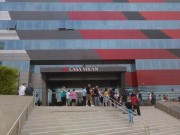Juventus could seal their sixth straight scudetto victory this weekend by avoiding defeat in Rome’s Stadio Olimpico, and as shown by the figures in all 20 Serie A clubs’ financial statements, the Bianconeri are as dominant economically as they are on the pitch.
Specialist football finance blogger Swiss Ramble has analysed the 2015/16 financial statements from clubs in Italy’s top division (period ending 30th June, 2016, except for Atalanta, Fiorentina, Genoa, Milan, Sampdoria, Sassuolo and Torino whose accounts closed on 31st December, 2015), revealing that Juventus are streets ahead of their rivals in terms of revenue and in their ability to pay player wages.

Juventus not only lead the way in Serie A by over €100 million in terms of their overall revenue, they have the 10th highest income in Europe according to the latest Deloitte Money League table. Roma, Milan and Inter were also listed in the top 20 clubs in the 2017 Deloitte Money League, though Champions League income was crucial to the Giallorossi’s 15th place position while both Milan clubs only saw small increases in revenue in 2015/16 (€15.6 million for Milan, €14.4 million for Inter).

Juventus have consistently increased the size of their wage bill over the last six seasons, overtaking both Milanese clubs who started the sample period at virtually the same level. This is likely to increase still further next season with their qualification for the Champions League final guaranteeing them over €100 million in additional income through prize money and TV revenue. Milan and Inter have both been forced to cut costs since 2011, but are still the 2nd and 4th highest spenders in the league; the American-led takeover of Roma and their subsequent consistently high league finishes (2nd, 2nd, 3rd) have seen them increase the amount they spend on wages by 45%. This has partly been made possible by the fact they have reached the Champions League group stages twice in the last three seasons, giving them the revenue necessary to spend more on wages. The effects of European TV revenue (in the graphic below) on clubs’ income are clear.

One area in which Serie A clubs have fallen a long way behind their competitors in Europe is in matchday revenue. Although Juventus, who own their own stadium, brought in a respectable €43 million in 2015/16, only six clubs earned more than €8 million (Juventus, Roma, Inter, Milan, Napoli and Fiorentina). In comparison, every single club in the Premier League except Bournemouth (€5 million) brought in €8 million or more in the 2015/16 season, while five (Manchester United, Arsenal, Chelsea, Liverpool and Manchester City) generated higher matchday revenues than the Bianconeri.

Sales of major players including Gervinho (€18 million), Alessio Romagnoli (€25 million) and Miralem Pjanic (€32 million) helped Roma achieve a €77 million profit on player sales in 2015/16. This was comfortably more than any other Serie A side, though Paul Pogba’s €105 million sale to Manchester United in August 2016 (filed in Juventus’ 2016/17 accounts) will certainly have a major bearing when analysing the current season.
 Overall, given Juventus’ strength, it is no surprise to see them come out having made a profit (of €12 million before tax) during the 2015/16 campaign. Almost half the league was profitable in 2015/16, though only the Bianconeri and their city rivals Torino (€15 million before tax) made notable profits. Inter and Milan both suffered heavy losses, but although the Nerazzurri’s loss of €56 million exceeded the €30 million limit imposed upon them by UEFA they still achieved their break-even target as the €56 million included costs that aren’t considered for Financial Fair Play purposes. However, the size of the pre-tax losses for both Milanese sides indicates the scale of the task lying ahead for both clubs’ owners as they attempt to take their respective clubs back up the table and compete for honours once more on both the domestic and European scenes.
Overall, given Juventus’ strength, it is no surprise to see them come out having made a profit (of €12 million before tax) during the 2015/16 campaign. Almost half the league was profitable in 2015/16, though only the Bianconeri and their city rivals Torino (€15 million before tax) made notable profits. Inter and Milan both suffered heavy losses, but although the Nerazzurri’s loss of €56 million exceeded the €30 million limit imposed upon them by UEFA they still achieved their break-even target as the €56 million included costs that aren’t considered for Financial Fair Play purposes. However, the size of the pre-tax losses for both Milanese sides indicates the scale of the task lying ahead for both clubs’ owners as they attempt to take their respective clubs back up the table and compete for honours once more on both the domestic and European scenes.








































